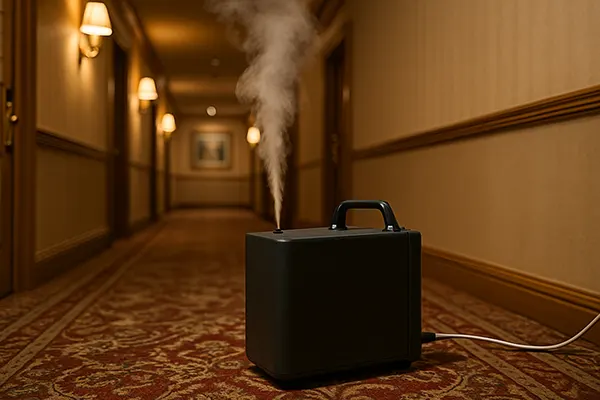
Olfactory marketing, or scent marketing, is a powerful yet often underestimated tool used by brands to subtly influence consumer behaviour. The sense of smell is directly linked to memory and emotion, making it uniquely effective in shaping buying decisions. In the context of casinos, retail spaces, and hospitality environments, the strategic use of scents can enhance customer satisfaction, prolong visits, and even increase spending.
The Psychology of Scent and Consumer Response
Our sense of smell is processed in the limbic system of the brain, which is also responsible for emotions and memory. This connection explains why a particular scent can evoke strong emotions or trigger specific memories. For businesses, especially those in competitive markets like casinos or retail, scent becomes a powerful tool to connect with customers on a deeper level.
Numerous studies show that pleasant smells can positively influence customer moods and perceptions. For example, a subtle floral scent in a retail store may make the environment feel more welcoming, encouraging customers to spend more time exploring products. The longer someone stays, the higher the chance of purchase or engagement.
In a 2022 study by the Journal of Consumer Psychology, participants exposed to a consistent, pleasant ambient scent rated the shopping experience more positively and were more likely to make impulsive purchases. This insight is invaluable for industries focused on increasing dwell time and consumer engagement.
Case Studies in Casino and Retail Spaces
Casinos in Las Vegas have long embraced olfactory marketing to enhance player experience. Signature scents are diffused through the ventilation systems to create a sense of luxury, cleanliness, and comfort. These scents are carefully chosen to avoid being overpowering while still subtly influencing the atmosphere.
For example, the Mirage Casino uses a unique coconut and pineapple scent to evoke tropical themes, aligning with its brand identity. Studies within such environments have shown a correlation between ambient scent and increased gaming duration, suggesting that players may feel more relaxed and engaged when surrounded by familiar or pleasant aromas.
In retail, brands like Abercrombie & Fitch and Nike use signature scents to create memorable store experiences. Customers often associate these smells with the brand itself, fostering loyalty and encouraging repeat visits. This brand-scent association becomes part of the customer journey, enhancing the brand’s emotional connection with its audience.
Types of Scents and Their Effects on Behaviour
Different types of scents can produce varied emotional and behavioural responses. Citrus scents like lemon and orange are typically associated with freshness and cleanliness, often used in healthcare settings and gyms. On the other hand, vanilla and cinnamon evoke comfort and warmth, making them popular choices in hospitality and casino settings.
Lavender is widely recognised for its calming properties and is commonly used in environments where relaxation is the goal. Casinos sometimes use lavender-based scents in lounge areas to help players feel more at ease, potentially extending their stay. Conversely, peppermint can increase alertness, making it suitable for workspaces or high-focus environments.
Understanding these associations allows businesses to tailor their scent strategies based on desired outcomes—whether it’s to encourage relaxation, excitement, trust, or cleanliness. Strategic scent placement is essential: high-traffic zones like entrances and waiting areas benefit most from a welcoming, subtle fragrance.
The Science Behind Scent Design
Scent designers, or olfactory branding experts, collaborate with businesses to craft a unique scent profile that matches their brand values and goals. This involves selecting top, middle, and base notes that blend harmoniously and are diffused using specialised HVAC systems or discreet dispensers.
The intensity, timing, and location of scent diffusion are critical. A well-designed scent strategy ensures that the aroma is noticeable but not overwhelming, maintaining a consistent presence throughout the customer experience. For casinos and large entertainment venues, uniform diffusion prevents scent fatigue and maintains brand consistency.
Advancements in scent technology now allow for programmable systems that can adjust scent intensity depending on time of day or visitor flow. This ensures that guests receive a fresh and positive olfactory impression regardless of when they arrive or how busy the location is.

Ethical and Strategic Considerations in Scent Marketing
While scent marketing offers numerous benefits, it must be implemented ethically and with consideration for health and inclusivity. Strong or artificial scents may trigger allergic reactions or discomfort in some individuals, so it’s crucial to choose hypoallergenic and non-intrusive formulations.
Transparency is key. Customers should not feel manipulated or deceived by invisible marketing techniques. Brands must ensure their use of scents enhances the experience rather than exploits emotional responses. Openly communicating the intent behind scent usage can foster trust and strengthen brand credibility.
Moreover, the effectiveness of scent marketing depends on cultural sensitivity. Different cultures may interpret scents differently—what’s calming in one region may be off-putting in another. Global brands must therefore localise scent strategies to reflect regional preferences while maintaining a consistent brand message.
Future Trends and Industry Adaptation
As personalisation becomes increasingly important in customer experience, the future of scent marketing may involve adaptive scent profiles based on real-time data. Smart scent systems could eventually adjust based on demographics, weather conditions, or customer behaviour analytics.
In the casino industry, future developments may involve integrating scent with other sensory inputs—such as lighting and music—to create fully immersive environments tailored to enhance player engagement and retention. This multisensory approach strengthens emotional resonance and increases brand loyalty.
Ultimately, businesses that view olfactory marketing as a strategic investment, rather than a decorative addition, are more likely to build meaningful connections with their audiences. When executed with care and innovation, scent can become a defining element of the customer experience.
